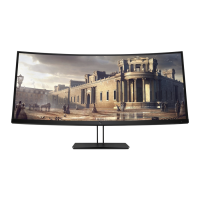
Do you have a question about the HP Z38c and is the answer not in the manual?
| 3D | No |
|---|---|
| HD type | UltraWide Quad HD+ |
| Pixel pitch | 0.22908 x 0.22908 mm |
| Display diagonal | 37.5 \ |
| Display resolution | 3840 x 1600 pixels |
| Display technology | LED |
| Native aspect ratio | 21:9 |
| Viewable size, vertical | 366.5 mm |
| Contrast ratio (dynamic) | 5000000:1 |
| Contrast ratio (typical) | 1000:1 |
| Display number of colors | 1.073 billion colors |
| Viewable size, horizontal | 879.6 mm |
| Digital vertical frequency | 24 - 76 Hz |
| Digital horizontal frequency | 27 - 130 kHz |
| Display brightness (typical) | 300 cd/m² |
| Supported graphics resolutions | 640 x 480 (VGA), 720 x 400, 800 x 600 (SVGA), 1280 x 1024 (SXGA), 1280 x 720 (HD 720), 1280 x 768 (WXGA), 1440 x 900 (WXGA+), 1600 x 1200 (UXGA), 1600 x 900, 1920 x 1080 (HD 1080), 1920 x 1200 (WUXGA), 1920 x 1600, 2560 x 1080, 2560 x 1600 (WQXGA) |
| On/off switch | Yes |
| USB hub version | 3.2 Gen 1 (3.1 Gen 1) |
| USB upstream port type | USB Type-C |
| VGA (D-Sub) ports quantity | 0 |
| USB Type-A downstream ports quantity | 3 |
| AC input voltage | 100 - 240 V |
| AC input frequency | 50 - 60 Hz |
| Power consumption (max) | 195 W |
| Annual energy consumption | 93 kWh |
| Power consumption (standby) | 0.5 W |
| Power consumption (typical) | 80 W |
| Product color | Black |
| Country of origin | China |
| Market positioning | Business |
| Tilt angle range | -5 - 20 ° |
| Number of OSD languages | 10 |
| Panel mounting interface | 100 x 100 mm |
| On Screen Display (OSD) languages | CHI (SIMPL), CHI (TR), DEU, DUT, ENG, ESP, FRE, ITA, JPN, POR |
| Depth (with stand) | 248 mm |
|---|---|
| Height (with stand) | 558.7 mm |
| Weight (with stand) | 13800 g |
| Depth (without stand) | 104.2 mm |
| Width (without stand) | 895.5 mm |
| Height (without stand) | 399.5 mm |
| Weight (without stand) | 9800 g |
Summarizes safety warnings, cautions, notes, and helpful hints for using the guide.
Details critical safety precautions and guidelines for handling and operating the monitor.
Overview of the monitor's capabilities, including front and rear component descriptions.
Advises on careful handling to prevent damage during setup, especially concerning the screen and stand attachment.
Step-by-step instructions for attaching the monitor's stand to the display panel.
Procedure for safely detaching the monitor's stand from the display panel.
Explains the IPS panel technology and its implications for image retention and potential damage.
Details the software and utilities, including INF, ICM files, and HP Display Assistant.
Explains the function of the INF file for monitor compatibility with Windows.
Describes the purpose of ICM files for consistent color matching in graphics applications.
Provides methods for installing monitor driver software and color profile files.
Instructions for installing software from the included optical disc, if available.
Guide to navigating and adjusting monitor settings using the OSD menu and its various options.
Explains the monitor's power-saving sleep mode and how to enable or disable it.
Lists common issues with their possible causes and recommended solutions for monitor troubleshooting.
Details how to lock and unlock monitor buttons, and the conditions under which this feature is available.
Information and data required when contacting HP technical support for assistance.
Instructions for finding the monitor's serial and product numbers on the rating label.
General recommendations for maintaining the monitor's performance and extending its lifespan.
Step-by-step instructions and cautions for cleaning the monitor screen and cabinet.
Advice on keeping original packaging for future shipping or moving needs.
Details about the monitor's display type, viewable image size, and physical dimensions.
Specifies the weight of the monitor with and without the stand.
Provides height, depth, and width measurements of the monitor when assembled with its stand.
States the highest resolution the monitor can support for graphics output.
Indicates the recommended resolution for best visual performance and clarity.
Specifies the distance between pixels on the display screen.
Indicates the pixel density of the monitor display.
Defines the range of horizontal scanning frequencies the monitor supports.
Specifies the range of vertical refresh rates the monitor can handle.
Lists operating and storage conditions, including temperature and humidity ranges.
Details the monitor's power input requirements, including voltage and current.
Specifies the altitude ranges for operating and storing the monitor.
Provides power usage figures for different operating states like full power, typical, and sleep.
Information on how HP products support various operating system assistive technologies.
Provides contact information for HP support, including phone numbers and operating hours.